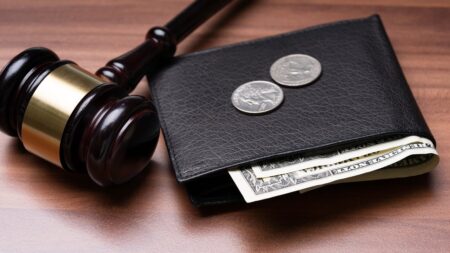Key takeaways
- In a Chapter 7 bankruptcy, creditors can seize certain assets to repay the debts you owe. However, exceptions allow debtors to retain some of their assets (or at least part of the asset’s value).
- Chapter 13 bankruptcy is more about restructuring debts than forfeiting assets. Under Chapter 13 bankruptcy, you agree to a three- to five-year debt repayment plan, based on your income, and creditors don’t seize your assets as long as you make your payments.
- Reaffirmation helps borrowers avoid having a specific asset, such as a home or automobile, seized during bankruptcy by confirming their intention and ability to repay that specific debt.
Many Americans mistakenly believe that filing for bankruptcy means losing all their assets to creditors who sell everything off to recover debts owed. But this isn’t the case. The government knows that allowing all your assets to be seized would leave you destitute, making it difficult for you to retain (or gain) employment and continue contributing to society. As a result, bankruptcy is designed to protect some of your assets so you can financially recover.
To that end, creditors can only claim certain assets as allowed by federal and state law. Furthermore, the type of bankruptcy filed (Chapter 7 vs. Chapter 13) determines how assets are handled. Ultimately, you may be able to walk away from bankruptcy with more than you think.
That said, filing for bankruptcy comes with serious financial consequences, so it is best left as a last resort. Consider other options such as debt management or debt consolidation, before committing to bankruptcy.
Ask for help
Bankruptcy law is complex and has recently undergone major changes. Debtors should seek legal counsel before filing for bankruptcy.
Assets in bankruptcy: The basics
When you file for bankruptcy, the court appoints a trustee to review your assets and debts.
You are required to list all your assets for the trustee, including:
- Intangible property: Non-physical assets such as alimony, child support and retirement savings
- Personal property: Belongings of value like vehicles, jewelry, clothing, artwork and collections
- Real property: Land and buildings
Asset protection under Chapter 7 vs. Chapter 13
With Chapter 7 bankruptcy, known as liquidation bankruptcy, you allow your non-exempt assets to be liquidated (sold for cash) to repay your creditors. In many cases, the value of the assets does not fully repay the debt, and the remaining debt is legally dismissed. However, certain debts cannot be discharged in bankruptcy, such as court-ordered payments, criminal fines and some tax liens.
With Chapter 13 bankruptcy, known as reorganization bankruptcy or a wage earner’s plan, you enter into a three- to five-year legal payment plan based on your disposable income. As long as you meet the terms of the repayment plan, you get to keep your assets.
You should not expect to be debt-free at the end of this period, however. After all, it can take 30 years to repay a mortgage. You will be expected to continue paying on those long-term debts after the Chapter 13 repayment period. However, some of your unsecured debt (such as credit cards) may be discharged if your payments do not cover the full amount during the period.
Assets creditors can take in Chapter 7 bankruptcy
In a Chapter 7 bankruptcy, creditors may seize assets to repay your debt. However, these assets are subject to federal and state bankruptcy exemptions, so there are limits and restrictions on the specific assets that can be claimed. Assets include:
- Artwork
- Collections
- Houses
- Investment properties
- Jewelry
- Land
- Savings and investment accounts
- Vehicles
- Other miscellaneous items of value
Federally exempt assets in bankruptcy
Bankruptcy exemptions help protect your property during bankruptcy by limiting what assets creditors can and cannot take from you. Exemptions vary depending on the process and the state.
Common federal bankruptcy exemptions include the following. These amounts apply to cases filed between April 1, 2022, and March 31, 2025, after which the amounts may change. Married couples filing jointly can double the exemption amounts listed.
Real property exemptions
Federal law doesn’t say that your primary residence (the house, condo, mobile home or other dwelling you live in) is exempt from liquidation during Chapter 7 bankruptcy. But it does say that a certain amount of your home equity is protected from creditors. This is called a homestead exemption.
The federal homestead exemption is $27,900. So if you have less than $27,900 in equity (or $55,800 for married, filed jointly), your primary residence is exempt by federal law.
If you have more than this amount in equity (and your state laws do not offer additional protection), your bankruptcy trustee will determine if it makes financial sense to liquidate the property, given market conditions and the fees associated with a sale. The house could be sold to repay creditors. However, you would be entitled to the exemption amount in cash. And, if there is any equity left over after creditors are paid, you would receive that amount as well.
Keep in mind:
Chapter 7 does not necessarily prevent your mortgage lender from foreclosing on the home if you fail to make mortgage payments. Any foreclosure proceedings will halt temporarily while the court sifts through your assets and debts, but the lender can request a “relief from stay” from the court to resume the process.
Vehicle exemptions
Creditors may pursue your vehicle during bankruptcy. However, $4,450 of the equity in your primary vehicle is federally exempt.
If your equity exceeds the limit (and state laws don’t offer additional protection) one of the following could happen:
- The trustee can sell your vehicle, give you the exempted amount, and use the remainder to pay creditors.
- The lender can repossess the car if you’re behind on your payments.
- You can give the vehicle back to the lender, which relieves you of the responsibility for the auto loan after bankruptcy.
Personal items and household goods exemptions
Commonly claimed federal personal property exemptions include:
- $1,875 for jewelry
- $2,800 for tools of your trade (so you can continue working)
- $14,875 in aggregate ($700 for each item) for household goods and furnishings, appliances, clothing, animals, books, crops or musical instruments
- $14,875 in accrued interest, dividend or loan value of a life insurance contract
- Professionally prescribed health aids
Wages, benefits and retirement account exemptions
Exemptions to protect your income, financial benefits and retirement savings include:
- Alimony or similar income you reasonably need for financial support
- Life insurance payments you need for financial support
- All Social Security benefits, unemployment benefits, veteran’s benefits, public assistance and disability or illness benefits
- Proceeds from your retirement accounts, up to the maximum aggregate value of $1,512,350 (in most cases)
Injury recovery exemptions
Exemptions for personal injury recovery include:
- $27,900 for personal injury recovery, not including pain and suffering or financial loss
- Compensation for loss of future earnings necessary for support
- Payment for the wrongful death of a person you depended on for support
- Compensation due to being a victim of a crime
Wildcard exemptions
The wildcard exemption can be used for any asset of your choosing. The exemption is $1,475 plus $13,950 of any unused portion of your property exemption.
State asset exemptions
Most states have their own exemption rules that differ from federal exemptions. You may be able to choose whether you would like to use the federal exemptions or your state exemptions. An experienced bankruptcy attorney can help you make the most advantageous choice.
Protecting specific assets with reaffirmation
Reaffirmation gives you a chance to retain ownership of a specific asset during bankruptcy by legally recommitting to making your payments on that asset.
For example, if you want to make sure you can keep your home, you can sign a reaffirmation agreement with your mortgage lender. You would agree to continue making on-time mortgage payments in exchange for the protection of that asset.
Lenders may be willing to work with you to restructure payments to make them more affordable while you work through your bankruptcy and financial recovery.
Additionally, reaffirmation can help soften the long-term impact bankruptcy has on your credit score. The reaffirmed account will remain active on your credit report and show on-time payments, which help rebuild your credit after bankruptcy.
Bottom line
Bankruptcy can provide a level of asset protection while helping you get out from under overwhelming debt. However, bankruptcy is an expensive process that comes with severe financial consequences, including:
- A lower credit score, which impacts your ability to secure future loans
- Higher interest rates on any future loans
- Potentially higher insurance premiums
- Grounds for landlords to deny your rental application
- A reason for employers to deny your application for certain jobs
Furthermore, with a Chapter 7 bankruptcy, creditors can seize any nonexempt assets and sell them to repay your debts. Before pursuing bankruptcy, consider other debt-relief options, such as debt consolidation or debt settlement, which may have a less damaging impact on your credit and future financial prospects.
Read the full article here
















